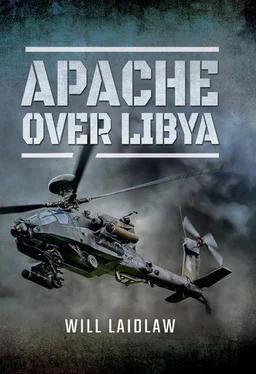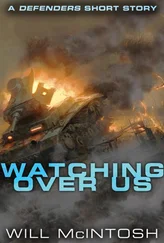Nick’s call was background noise now in the flip-flop. All eyes were on the maps, the numbers and the weapons load. Nick talked the detail with Glen; the rest of us ran the plan.
Little Shippers brought up the maps on the mission planning system and began drawing planning lines – cigarette packet calculations in modern wiggly-amp ways. He was looking for places to cross the beach, how to find the right approach and identify the wires, the best escapes, emergency landing places and water sources. From this he could give a time estimate to the target, time available at the target and the fuel we would need to get home to Mother. Little Shippers was faultless with numbers – time, fuel and aircraft performance were his specialities.
‘Feasible’ could only come from the CAOC. If they could get something to validate the target so their rules on launching us were satisfied, then we would be good to go. The chances of launching were entirely down to how much the CAOC wanted us to fly.
With the phone call done, Nick briefed us:
Possibly two missions on different nights. Just a pair of aircraft for each. One lot of targets here near this town [he pointed at Bi’r al Ghanam, just 45 miles south-west of Tripoli and clearly on the main road between the capital and the mountains]. The other is here at this random desert road junction and the airfield nearby. It’s being used as some sort of staging point sending troops down to the front line. [He now pointed to Okba airfield, deeper into the desert]. Mission one on the night of the 4th. Mission two the following night or perhaps a couple of nights later, depending on how the first one goes. The initial target packs should come through tonight or tomorrow. The reconnaissance photos are quite old, but it’s all we have to plan with. Once we’ve come up with the outline route and timings we should have more recent imagery. They are apparently going to do some overflights with photo-pods tomorrow.
‘Pred?’ I asked. ‘I mean, on the mission night.’
‘No,’ fraid not. Jets, either F-16 or Tornado, are being allocated.’
‘Great, so we’re on our own again then.’ John Blackwell injected some humour. ‘Bit like in Brega when the triple-A and SA-6 were lashing about and nothing came from on high to make a difference…’
Jay cut him off: ‘Well, you’re not really on your own, John. See, you and the boss are together, in the Ops Room on the radio. You’re not on the mission, either of them, look at the schedule!’
Everyone laughed, apart from John and I. I looked at the schedule. Jay was right.
John was cut down to size: ‘Right, I’ll go and make the tea then, just as soon as I’ve finished counting the morphine and polishing your boots!’ He accepted his place. Eight aircrew kept laughing and John and I waited for them to stop. We would sit these missions out. Everyone had done so before and now it was our turn.
Nick had three days to plan. The target areas were given, but the target imagery was weeks old. He held on to the promise of better pictures and spent his time working the route in and the route out. Target packs would always grow as reconnaissance sorties confirmed the viability of the target. When a target area was being considered the NATO Targeting Board would take interest and demand more information. More reconnaissance was flown, better images were obtained and analysed and weapon types were recommended. Eventually, the Targeting Board would agree to the target and allocate it to a particular aircraft type. Often late in the afternoon of the mission the Targeting Board would say ‘yes’ or ‘no’ to our target for that night. To us this meant ‘fly’ or ‘cancel’.
If the mountains were a genuine target area the old imagery would have to be updated. However, this target pack didn’t develop. Nothing much had happened in the area for weeks, and it was not receiving much NATO interest. With this scant level of understanding a similar mission along the coastline around Zlitan or Tripoli would have been dismissed early or cancelled on the day. However, as we had never been there before, we had surprise on our side that de-risked the mission just enough to get a green light. The senior men decided the risk was worth the reward. In the background Glen had worked hard to convince them and he knew this would open up a whole new range of options for us. So, while we had very little detail apart from coordinates and an outline description of a collection of vehicle checkpoints, the mission was gaining traction. It looked like a ‘Go’.
With a day to go, Nick agreed the launch point and the recovery point with the ship’s Ops team. He selected the ingress point and a separate egress point on the coast, a key vulnerability for us. Little Shippers and JB spent hours scrutinizing the satellite imagery looking for wires and other hazards over all 50 nautical miles to the target and the 50 nautical miles back. Adding the 50 nautical miles of sea transit meant they would have little time for diversions or unscheduled fights if they were to have maximum effect at the target end. They also knew that if they turned for Mother with little ammunition and fuel left, the run home could be a ragged gauntlet.
Bi’r al Ghanam is the first significant settlement after a northerly descent from the mountains on to the low desert plain. An army on the march had two options: head north to the coastal city of Az-Zawiyah and then east along the coast to Tripoli; or straight north-east to the capital. Owning the town and the road meant control of the region. Our target checkpoints were strung out along the main road that ran northeast towards Tripoli. This road was considered to be a key strongpoint for pro-Gad. It prevented the FLF getting out of the mountains and it enabled easy re-supply to help keep them pinned down. Disrupting that strength might help open a gap in the pro-Gad defence and just might encourage the FLF to exploit an opportunity to advance.
Although the mission would be long, it was planned in our now standard way. Take-off and low-level sea transit, up to 30 nautical miles of it. Cross the coast, guns ready. Race into the desert and cover 50 nautical miles still at low-level, lower than the wires, to the target. Arrive, observe, decide shoot or no shoot. Three separate strikes. Break off. Another 50 nautical miles, again lower than the wires, cross the coast, low on fuel with guns ready, and then out into the black to find Ocean 20 nautical miles north in the Med. Seven phases, each briefed in minute detail. They knew their heights, speeds, times, approach angles, weapon choices and trigger pulls. They also knew how they might undo heat-seeking surface-to-air missiles, triple-A and anything else pro-Gad might throw into the sky.
It was a typically aggressive plan: strike the most heavily defended area first with surprise intact, then see what was left. Depending on the weather conditions and the flight profile, the enemy would likely hear them during their run in to the first target. Pro-Gad might get as much as 40 seconds of prior warning if he was listening hard and was able to break out and interpret the low thunder of the Apache on its attack run. The first Hellfire impact would confirm any doubts. After that, the meticulously briefed and rehearsed plan was just a set of ideas Nick could shape into hasty orders for subsequent strikes.
The first and second sites were within a few miles of each other, so surprise would be lost at the first trigger pull. This was about rapid target confirmation followed by maximum firepower. Nick wanted to minimize the attack runs to get as much firepower as possible down on the target with minimum time between trigger pulls. He would have to locate, identify and prosecute as many of the enemy as possible, ideally all in one run. The CO and Jack Davis had been meticulous in their discussions with the CAOC lawyer – the ROE were good to go, pro-Gad owned the space and no one else was there. If it looked military, it was a valid target.
Читать дальше












